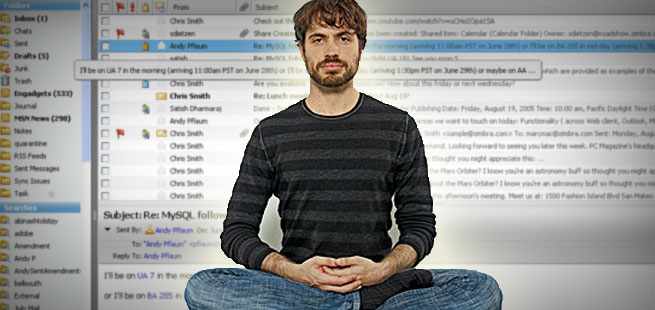
If you really want to get Justin Rosenstein going, ask him what he hates about work.
The bearded engineer (pictured) used to work at Facebook; he left in 2008 to co-found Asana, a startup that aims to put a stop to “work about work.” Today, the company is launching Asana Inbox, which strikes another blow against bloated software and useless communication that define the average Dilbert-esque office space.
You know the kind of fake-work we’re talking about here. It’s everything that takes up your time but doesn’t actually accomplish anything: status update meetings, one-on-ones with your manager where the first question is, “So, what have you been working on lately?” And those endless email chains that you neither want nor need to read but on which you are included anyhow because… Because.
Rosenstein pretty much thinks all that crap is, well, crap. And his mission is to create a Utopia where email doesn’t exist.
“People spend an enormous amount of time in their inboxes, compulsively checking,” he said in an interview yesterday at Asana’s San Francisco HQ. “And it’s slow, distracting, and inefficient. It’s almost a counterproductivity tool.”
What Asana brings to the table today is somewhere between a checklist and a briefing. It’s not bloated project management software (the kind your boss might institute and which you’d never voluntarily use). Rather, it has a super simple but deadly efficient interface that lets you skim and skate through your morning’s round of tasks and projects with ease and speed.
We’re generally rather blasé about apps in general, but Asana Inbox is hot. Hot like an assassin who is killing every namby-pamby piece of B.S. in your corporate life and letting you get back to being a creative genius.
Slaying tasks with lightning speed has its psychological benefits, too.
“It’s incredibly satisfying,” Rosenstein said. “You have a very real sense of clarity on what you’ve done, what everyone else is working on, how to get to your milestones, how far away you are from accomplishing your project… It makes you calmer and faster, and it emboldens you to take on even more ambitious projects in the future.”
Here’s what the new product looks like:
[vb_gallery id=480754]
Basically, when you open Asana Inbox, you’ll see a string of updates on tasks you’re working on. Because there are no chains of copied texts or subject lines that you have to click through, the scanability factor is incredibly high.
Once you’ve read an update, it gets archived. Gone. Boom. You can choose to flag it, but by default, it gets out of your way.
“It’s really optimized for speed… to get you in and out as much as possible,” said Rosenstein. “The amount of time and energy and stress people spend getting to inbox zero… we’ve created a world where inbox zero is the path of least resistance… Getting to inbox zero is now really easy and natural for me.”
You can use Asana Inbox as your default for getting tasks done regardless of whether or not your colleagues (either inside your company or at another company) are using Asana; they can update Asana tasks from their own email inboxes. That is, until they decide to make the switch, something Rosenstein anticipates if only because he’s seen it happen so many times already with his software, which just recently became a paid product.
“We’ve already seen this sort of viral adoption,” he told us. “It can start with just one person, and then they invite one more person and a few more people to the project. Different departments that don’t even know each other start using Asana, and then it comes to IT’s attention.
“A lot of that comes from our background in the consumer world: You create a great product that’s well designed, and people share it with each other.”
Asana has been highly optimized for organic growth, in other words — and it has been so designed by former Facebookers, masters of consumer products, virality, and massive growth.
Still, slaying email is bound to be an uphill battle; we asked Rosenstein if it wasn’t a bit optimistic to expect huge companies with armies of middle managers to throw over the familiar for the unfamiliar, no matter how efficient.
“Email isn’t going away tomorrow… but it wasn’t designed for the coordination of complex tasks,” he said. “It’s the lowest common denominator, you can do anything poorly in email… We’ve really outgrown the limits of what that technology can support.
“We know a post-email world is coming. Asana is the first credible post-email application.”
Finally, we ask, what will all the managers do when Asana and other post-email apps take away the busywork of work?
Rosenstein gives Asana, the startup, as an example. More than half the internal emails sent back and forth have been eliminated since the company started using its own Inbox. As a result of the new task management tool, he said, “Our meetings are not status meetings. They’re about talking about intellectually meaty design problems or product ideas. It’s stimulating, and it leaves the coordination to the robots.”
And for the average middle manager or executive, Rosenstein said the new tools “would empower him, it would transition him from a manager to a leader — inspiring, interacting, and doing the higher-order things that he really does enjoy.”
And that freeing-up of our hands to allow for the better, more efficient functioning of our minds — isn’t that what technology is meant for in the first place?
VentureBeat's mission is to be a digital town square for technical decision-makers to gain knowledge about transformative enterprise technology and transact. Learn More

